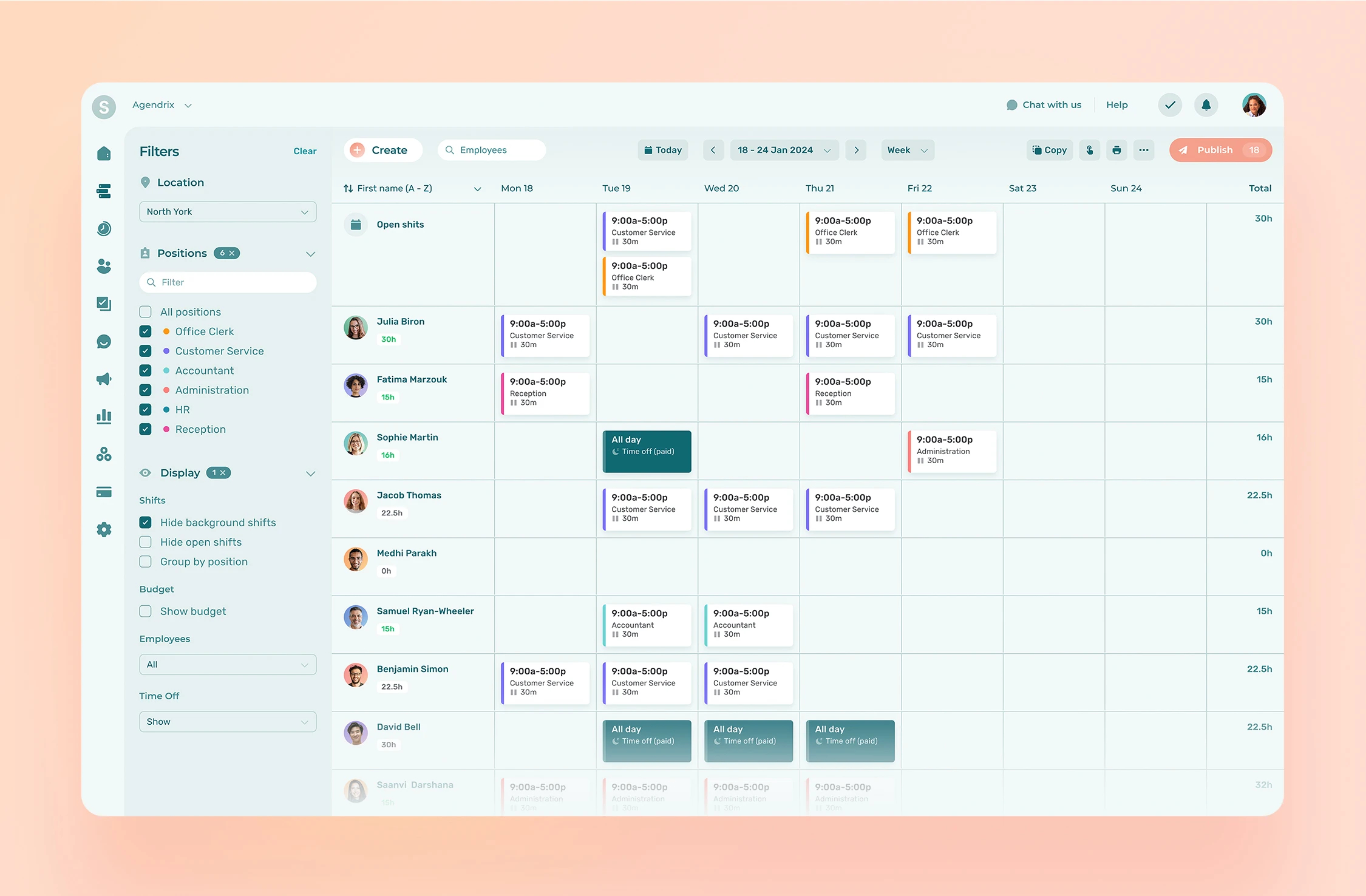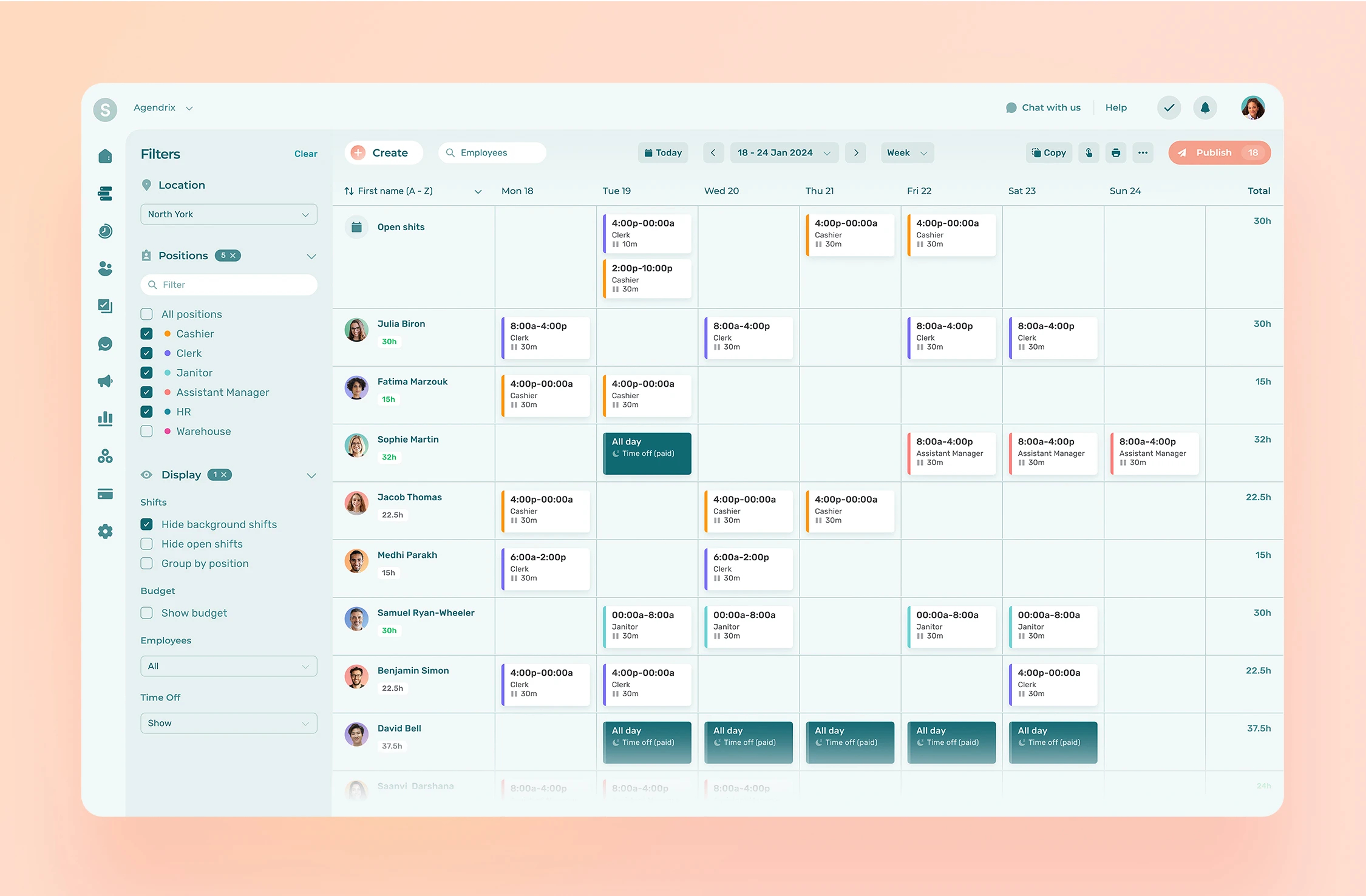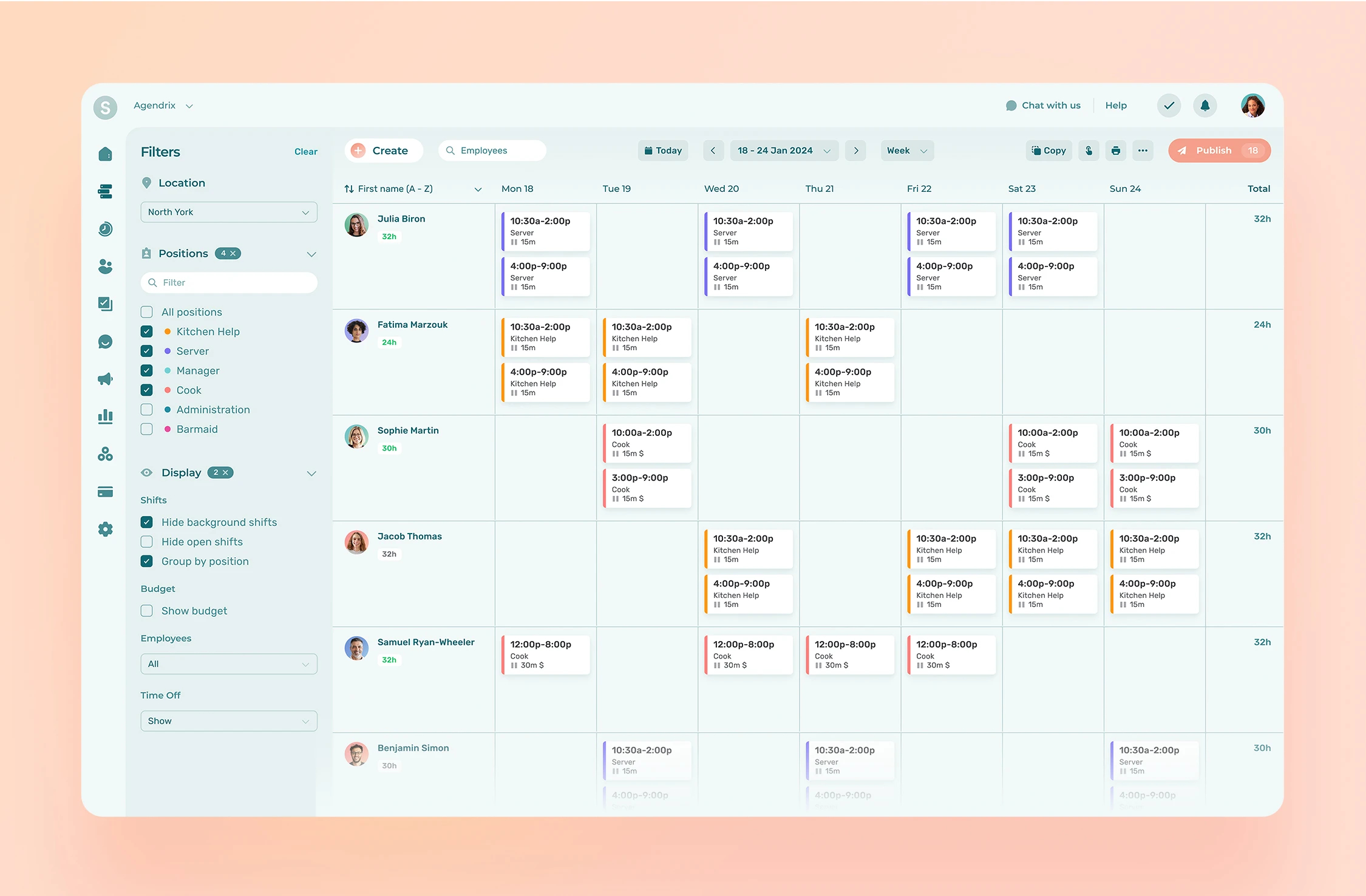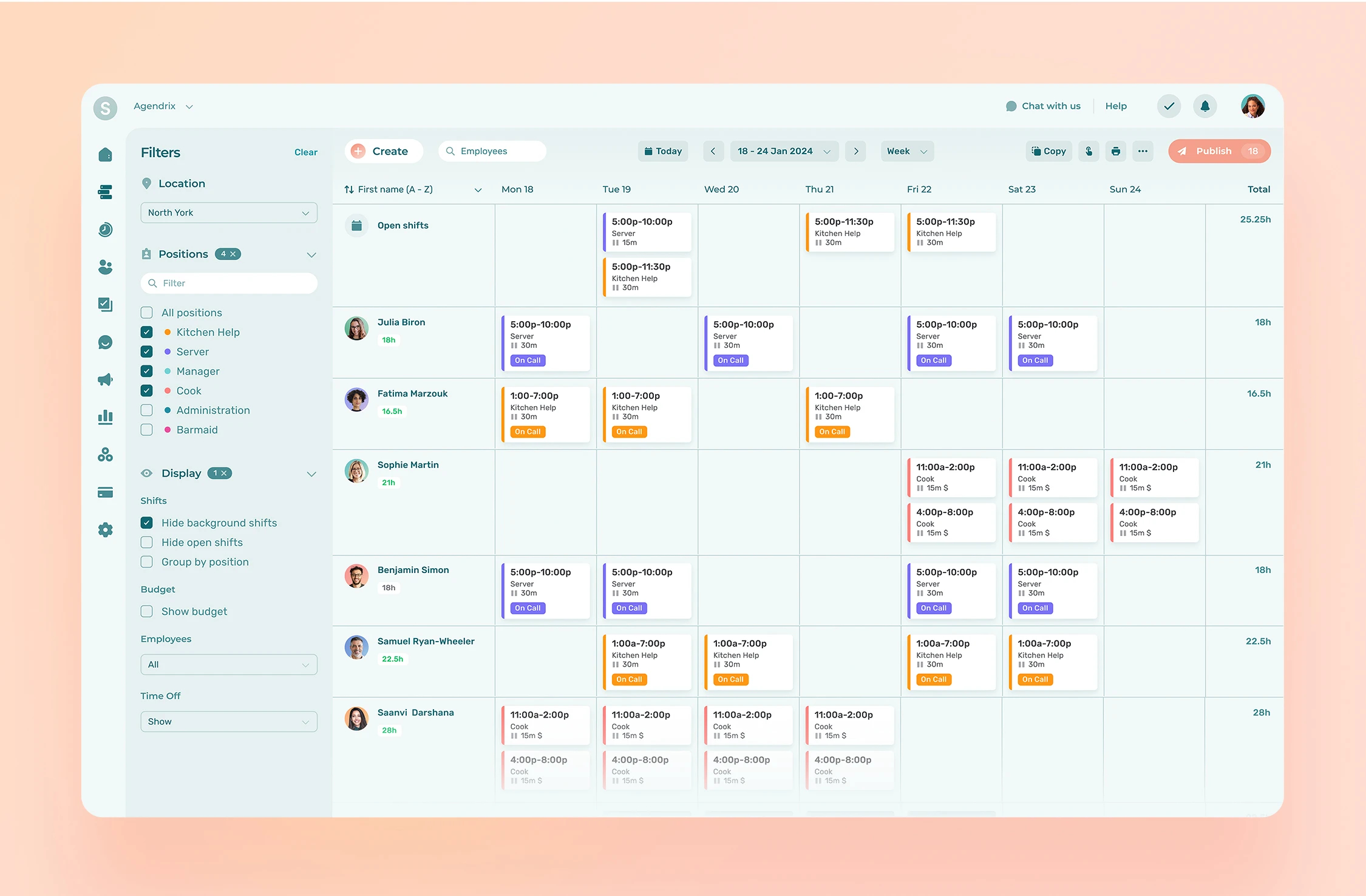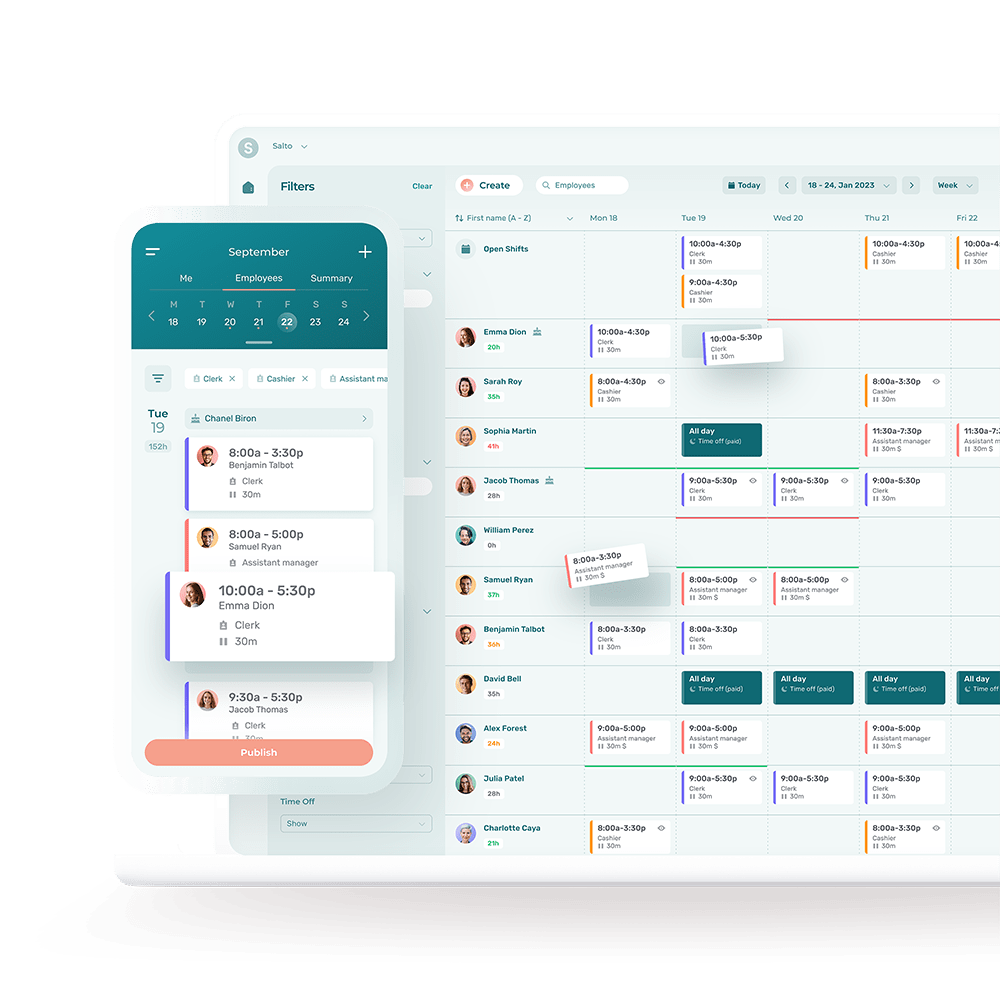Finding the work schedule that best meets the needs of your business and team members can boost employee productivity, customer service, and job satisfaction. And most likely, profitability, too.
See the most common types of work schedules, the types of jobs and industries for which they make the best fit, and the main benefits and drawbacks for both employees and employers. We also include a visual example of a schedule for each type of work schedule so that you can see how it might apply to your business.
Traditional 9-5 Schedule
Best for: Office-based roles, corporate sectors, and administrative jobs. Common in industries like finance, law, and HR.
How a Traditional 9-5 Schedule Works
The traditional 9-5 work schedule is an organized schedule that never or hardly varies. It follows the standard workday where employees start work at 9:00 a.m. and finish at 5:00 p.m., typically with a one-hour break for lunch. The schedule could also be from 8:00 a.m. to 4:00 p.m., for instance.
This eight-hour workday has become synonymous with the regular full-time schedule found in the daily routine in many countries. The workweek often begins on Monday and ends on Friday.
Learn how to create a schedule properly with our free work schedule templates.
Pros and Cons of the Traditional 9-5 Schedule
Main benefits for employees:
- Offers a consistent and predictable routine
- Aligns with societal norms and facilitates a work-life balance
Main drawbacks for employees:
- Lacks the flexibility needed by some workers for health or other personal reasons
- Can make it challenging to manage personal tasks and peak productivity periods outside of standard work hours
Main benefits for employers:
- Simplifies coordination and scheduling
- Makes synchronizing professional interactions easy as many people work the same hours
Main drawbacks for employers:
- No flexibility to adapt service hours to different customer demands or employee needs
- Can potentially lower employee motivation or productivity outside of peak periods
Example of a traditional 9-5 schedule
Below is an example of what a traditional 9-5 work daily schedule template would look like in Agendrix employee scheduling software.
Shift Work Schedule
Best for: 24-hour operations such as manufacturing plants, hospitals, and emergency services. Also suits the hospitality and retail sectors.
How a Shift Work Schedule Works
With a shift work schedule, different sets of employees work specific periods or “shifts.” This allows the business to operate beyond the standard daytime work hours, up to a full 24-hour day.
Shifts may be worked on a full-time or part-time hourly basis. They can be categorized in various ways, such as morning, afternoon, and night shifts (or first, second, and third shifts), depending on the organization’s needs.
Pros and Cons of a Shift Work Schedule
Main benefits for employees:
- Offers flexibility in working hours
- Potentially aligns with personal preferences or allows for off-peak commuting and personal errands
Main drawbacks for employees:
- Shifts may not align with societal norms
- Can disrupt natural circadian rhythms, potentially leading to sleep disorders, fatigue, and health concerns
Main benefits for employers:
- Enables 24-hour operations
- Ensures continuous service or production to maximize output
Main drawbacks for employers:
- Requires careful management to avoid overworking staff
- Can lead to higher turnover rates due to the demanding nature of the schedule
Example of a shift work schedule
Below is what a basic shift work schedule template would look like in Agendrix employee scheduling software.
Create and publish employee schedules in just minutes with Agendrix. Automatically track employee hours, absenteeism, late shows, labor costs, and more. Simplify payroll reporting.
Learn more about Agendrix employee scheduling software.
Rotating Schedule
Best for: Jobs that require 24/7 coverage but don’t necessarily need the same employees present all the time, such as nursing, customer support, and security.
How a Rotating Schedule Works
With a rotating shift schedule, employees rotate through a cycle of different shifts, often over a 24-hour workday. This rotation can occur on a daily basis, a weekly basis, or even a monthly basis. A cycle can even last several weeks.
In a rotating shift pattern, an employee might work the day shift for a specified period, rotate to the afternoon or night shift for the next period, and then rotate back to the day shift after completing the cycle. The frequency and direction of the rotation (e.g., day to night vs. night to day) can vary based on the organization’s needs and the nature of the job.
Pros and Cons of a Rotating Schedule
Main benefits for employees:
- Offers more flexibility to work with a wider range of co-workers and attend to personal needs during standard work hours
- Ensures fair distribution of shifts; no single group is perpetually stuck with less desirable work hours
Main drawbacks for employees:
- Constantly changing work days and hours can make family obligations like childcare more difficult to manage
- Can disrupt an individual’s circadian rhythm
Main benefits for employers:
- Provides operational continuity
- Improves the skillsets of employees by exposing them to different shifts
- Promotes fairness by distributing the burden of less popular shifts across the workforce
Main drawbacks for employers:
- Can complicate scheduling
- Can lead to decreased productivity or increased errors during transition periods between shifts
Example of a rotating work schedule
This is what a basic rotating work schedule might look like in Agendrix employee scheduling software.
Compressed Work Week
Best for: Roles and projects where productivity doesn’t necessarily equate to hours worked. Suits project-based roles and routine tasks where longer stretches of concentration are beneficial.
How a Compressed Workweek Schedule Works
A compressed weekly work schedule is an alternative work arrangement where employees work a traditional 40-hour week in fewer than the standard five days. This means longer daily hours but fewer working days in one week.
One of the most common compressed schedules is the weekly “4/10” format, where employees work four 10-hour days weekly to receive an extra day off each week.
Pros and Cons of a Compressed Weekly Work Schedule
Main benefits for employees:
- Longer work days give certain employees more time to complete important tasks
- Extra day off each week means longer weekends to manage personal time
Main drawbacks for employees:
- Extended daily working hours and trying to get an entire week of work done in one fewer day can be physically and mentally tiring
- Can potentially affect work-life balance, lead to increased fatigue and even burnout
Main benefits for employers:
- Extended service hours without having to manage daily shift transitions
- Can potentially increase productivity
Main drawbacks for employers:
- Longer work days might strain resources and facilities
- Can lead to decreased employee morale over time if not managed well
Example of a compressed weekly work schedule
A compressed weekly schedule template will look something like this in Agendrix employee scheduling software.
Master the shift scheduling process. Take our deep dive on scheduling shifts.
Split Shift
Best for: Foodservice jobs, school bus drivers, or any role that experiences significant demand peaks at different times of the day.
How a Split Shift Schedule Works
A split shift work schedule is a type of work arrangement where an employee’s workday is divided into two or more distinct periods of work, separated by longer-than-usual breaks.
Instead of a continuous block of work hours, an employee might work a few hours in the morning, have a lengthy break in the middle of the day, and then return to work in the late afternoon or evening.
Pros and Cons of a Split Shift Schedule
Main benefits for employees:
- Extended breaks leave more time in the daily agenda to rest or tackle one’s personal to-do list
- Potentially offers a better balance between work and personal time within a day
Main drawbacks for employees:
- Fragmented workday can disrupt personal plans
- Can potentially prolong the total time dedicated to the job, making it feel like the workday never truly ends
Main benefits for employers:
- Matches staffing to peak demand periods to optimize resources
- Ensures service or production during crucial times
Main drawbacks for employers:
- Might lead to decreased employee satisfaction due to the perceived long workdays
- Can complicate the coordination of team tasks or meetings
Example of a split shift schedule
Here’s an example of a schedule following a split shift pattern as it might look in Agendrix employee scheduling software.
On-Call Schedule
Best for: IT support, medical specialists, and other roles where immediate response is occasionally required but constant presence isn’t.
How an On-Call Schedule Works
An on-call work schedule refers to a work arrangement where employees do not work fixed hours but instead must be available to be called into work as and when required. In other words, on-call employees must be available and ready to report to work on short notice.
Google calendar or a simple table not meeting your scheduling needs? Download our free on-call weekly schedule template.
Pros and Cons of an On-Call Schedule
Main benefits for employees:
- Offers potential flexibility during periods when not actively called into work to attend to personal activities or other commitments
Main drawbacks for employees:
- Employees need to stay flexible as the unpredictability of calls can disrupt personal plans and rest, making it challenging to maintain a work-life balance
- Can lead to increased stress
Main benefits for employers:
- Provides a cost-effective way to handle unexpected demands without having to staff positions continuously
- Optimizes resource allocation
Main drawbacks for employers:
- Reliance on a limited pool of on-call employees might strain these workers
- May lead to higher turnover or burnout rates and potentially compromise service quality
Example of an on-call schedule
This is what an on-call work schedule might look like in Agendrix employee scheduling software.
Work smarter, not harder.
Here are 10 Employee Scheduling Tips to Simplify Your Shift Schedules.
Flextime Schedule
Best for: Organizations looking to offer more autonomy and flexibility to their employees. Suitable for roles that don’t rely on specific working hours.
How a Flextime Schedule Works
The flextime (or “flexible time”) work schedule is a type of work arrangement that allows employees to customize their workday start and finish times within certain limits set by their employers. Typically, there’s a core period, often in the middle of the day, when all employees are required to be present, but the start and end times outside of this core are flexible.
For flextime to be effective, clear communication and trust between employers and employees are crucial. Employees must also be autonomous enough to prioritize work and manage their time effectively.
Pros and Cons of a Flextime Schedule
Major benefits for employees:
- Freedom to set one’s work start and finish times around personal needs and peak productivity periods
- May reduce commute stress
Major drawbacks for employees:
- Without clear boundaries, work hours might blend into personal time, potentially disrupting the work-life balance
Major benefits for employers:
- Increases employee satisfaction and productivity by allowing them to work during their most efficient hours
- Potentially extends operational hours
Major drawbacks for employers:
- Can complicate team coordination and make meetings harder to schedule
- Requires robust communication tools and clear policies to ensure effectiveness
Create the Perfect Adaptable Schedule With Agendrix
Agendrix employee scheduling software is suitable for any business that needs robust yet easy-to-use employee scheduling software. Its intuitive, user-friendly design makes creating conflict-free schedules quick and easy. It seamlessly integrates with time tracking to streamline payroll processes and reduce administrative burdens to improve time management.
Agendrix’s top-rated feature among managers: The built-in employee communication platform. When changes occur in the daily schedule, employees are instantly notified (no more emails, texts, phone calls, or Facebook Messenger chats). This saves managers considerable time over one week, while also minimizing misunderstandings and no-shows.
Agendrix’s top-rated feature among employees: Its compatibility with multiple devices, including smartphones. Workers can access their schedules, request time off, or swap shifts all on the go, leading to a more flexible and collaborative schedule.
Agendrix software consolidates these and many other essential employee management and scheduling functions in one comprehensive solution. Easily manage all your tasks relating to creating a weekly schedule and preparing reports for payroll. It will track labor costs, facilitate compliance with labor laws, and reduce schedule errors.
How Can I Determine Which Work Schedule Is Best for my Business?
Here’s a handy guide to help you make this decision:
Analyze business needs
- Operating hours: Does the business require 24/7 operations, standard business hours, or fluctuating hours based on customer demand?
- Peak periods: Identify times when customer demand is highest. Retail businesses might see weekend rushes, while a tech support team may need to be available 24/7.
Gauge employee preferences and needs
- Surveys: Conduct surveys to understand employee preferences. This can improve morale and employee retention.
- Work-life balance: Recognize the importance of work-life balance for overall well-being and productivity.
Assess the nature of the job
- Some roles, like creative tasks, might benefit from flexible hours, whereas others, like customer service, might require fixed shifts.
Consider the financial implications
- Some schedules can lead to higher wages (e.g., night differential for night shifts) or reduced operational costs (e.g., savings from allowing remote work).
Evaluate tools and technology
- If not already in place, look for a good employee scheduling tool to save time on scheduling tasks. If considering flextime or remote working, ensure that the company has the technological infrastructure to support this. Among other tools, you may need communication tools, a time tracker, and task management software.
Review regulatory and legal constraints
- Certain industries or regions might have regulations regarding work hours, overtime, and breaks.
Pilot and adapt
- Before committing to a new schedule, pilot it for a certain period to get a better idea of its pros and cons. Give it some time; one week is not long enough. Gather feedback, assess productivity, and make adjustments as needed.
Collect feedback
- Put in place a feedback mechanism to regularly solicit comments from employees about the schedule. A clear structure and an open line of communication can help in addressing issues, such as challenges in balancing work and personal life, before they become significant problems.
Stay informed
- Business needs and industry standards evolve. Regularly review and adjust your schedule based on new insights, changing business needs, and employee feedback.
How Can Scheduling Choices Impact Business Performance?
Is your chosen daily schedule important to your bottom line? The answer is a resounding yes, in a myriad of ways.
Productivity
- Positive: Scheduling workers during their peak productivity hours can maximize output.
- Negative: Poor scheduling can lead to overworked employees, causing fatigue and a decline in performance.
Employee morale and satisfaction
- Positive: Flexible schedules, regular breaks, and consideration of employee preferences can boost team morale.
- Negative: Inconsistent or unpredictable schedules can lead to dissatisfaction and increased staff turnover.
Operational costs
- Positive: Efficient scheduling can optimize labor costs by aligning workforce availability with business needs.
- Negative: Overstaffing or understaffing can result in unnecessary overtime payments or lost sales respectively.
Customer service and experience
- Positive: Proper staffing during peak times ensures customers are attended to promptly.
- Negative: Understaffing can lead to longer wait times, reducing customer satisfaction.
Employee health and well-being
- Positive: Balanced schedules with adequate rest periods can promote employee well-being.
- Negative: Continuous long hours, rotating shifts, or irregular schedules can adversely affect health, increasing absenteeism.
Team collaboration
- Positive: Coordinated schedules ensure teams can collaborate effectively.
- Negative: Misaligned schedules might hinder communication and collaboration.
Employee retention rates
- Positive: Employees are more likely to stay with companies that offer favorable and predictable schedules.
- Negative: Constantly changing or unfavorable schedules can lead to higher turnover.
Regulatory and legal compliance
- Positive: Adhering to labor laws and regulations avoids legal complications and potential fines.
- Negative: Non-compliance due to poor scheduling can result in legal repercussions and damage to reputation.
Adaptability and scalability
- Positive: Flexible scheduling models can allow businesses to adapt quickly to fluctuating demands.
- Negative: Rigid schedules might make it challenging to scale up or down based on demand, affecting agility.
Reputation and brand image
- Positive: Companies known for good employee treatment and responsiveness to customer needs enhance their brand image.
- Negative: Poor scheduling leading to noticeable employee distress or customer service lapses can harm a company’s reputation.
What Metrics Can I Use to Determine if my Chosen Schedule Meets Business and Staffing Needs?
Here are some key metrics to consider and regularly review to ensure your chosen schedule type is providing the desired results.
Operational efficiency metrics
- Schedule adherence: Measure the percentage of shifts started and ended as per the set schedule.
- Overtime hours: A consistent need for overtime might indicate understaffing or scheduling inefficiencies.
- Shift coverage: Monitor the number of uncovered shifts or last-minute replacements needed.
Employee satisfaction and well-being
- Employee turnover rate: High turnover can indicate employee dissatisfaction with the scheduling.
- Employee feedback and surveys: Regularly solicit feedback specifically about scheduling preferences, concerns, or recommendations.
- Absenteeism rate: A high rate might indicate burnout or dissatisfaction.
Customer service metrics (for customer-facing roles)
- Wait times: Extended customer wait times can point to scheduling gaps during peak hours.
- Customer satisfaction surveys: Customers might give feedback about service delays or understaffing, indirectly reflecting on the scheduling efficiency.
Productivity metrics
- Output per hour: Measure the quantity or quality of work produced relative to hours worked to see if there are dips in productivity at certain times.
- Task backlog: In jobs with quantifiable tasks, an increasing backlog might point to scheduling or staffing inefficiencies.
Financial metrics
- Labor cost percentage: Calculate labor costs as a percentage of revenue. A significant increase may warrant a review of scheduling practices.
- Cost of turnover: Factor in recruitment, training, and other costs associated with replacing employees. High costs could be a sign that scheduling practices are contributing to turnover.
Flexibility and adaptability
- Shift swap requests: If there are frequent requests for shift changes or swaps, it might indicate that the schedule isn’t aligning well with employee needs or preferences.
- Unplanned absences: A high rate of unplanned absences and no shows might indicate burnout, dissatisfaction, or personal conflicts with the set schedule.
Communication and conflict metrics
- Number of schedule conflicts: Regular conflicts might point to a need for more transparent communication or a reconsideration of the scheduling process.
- Grievances or complaints: Track formal and informal complaints related to scheduling to identify patterns or areas of concern.
Adherence to regulations
- Compliance violations: Monitor for any breaches in labor laws, such as missed breaks or exceeded work hours. Frequent violations can indicate scheduling issues.





